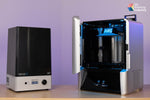
3D Printing Industry reviews the Nexa3D XiP 3D printer.
, by Misty Rainwater, 3 min reading time

, by Misty Rainwater, 3 min reading time
Comparatively cheaper than other resin systems, it can also handle 4K quality prints with details as intricate as 50µm. As an added benefit, Nexa3D has designed the XiP to be open material. Adopters can therefore configure third-party resins for use with their machine.
3D Printing Industry reviews the Nexa3D XiP 3D printer.
Based in California, Nexa3D markets its resin systems as a means of “taking current additive manufacturing speeds from the age of ‘dial-up internet’ to ‘broadband’. Putting this, and other claims, to the test, our engineering team has reviewed the Nexa3D XiP, the firm’s latest ultrafast desktop 3D printer.
With the XiP, Nexa3D has made its first foray into the desktop market, having previously launched the larger NXE 400Pro and QLS 820 systems. However, with the XiP, the firm hasn’t skimped on quality, and users can expect to benefit from its usual technical prowess, albeit at a more affordable price.
At the heart of the XiP is Nexa3D’s Lubricant Sublayer Photo-curing (LSPc) process. LSPc is essentially an enhanced masked stereolithography (mSLA) technology, that In the case of the XiP, allows for the 3D printing of large models at speeds of up to 18 cm per hour.
Comparatively cheaper than other resin systems, it can also handle 4K quality prints with details as intricate as 50µm. As an added benefit, Nexa3D has designed the XiP to be open material. Adopters can therefore configure third-party resins for use with their machine.
In our review, we’ve taken a deep dive into the proposed benefits of these features, through our usual set of resin tests and benchmarks. This, in turn, allowed us to accurately gauge the quality of the parts the XiP’s able to produce. Read on for our full impressions and verdict on the machine’s capabilities.
Compact, professional desktop 3D printing
The XiP’s headline speed and accuracy benefits are largely down to the LSPc technology it’s built around. With the machine, Nexa3D has effectively taken this technology from its industrial resin printers, and shrunk it down to desktop size. The process itself involves using an LCD photomask to block an LED array, so that it only lets through the light needed for material curing.
This is in stark contrast to traditional SLA systems, which tend to use a laser to draw out the area of a print, curing the resin as it goes.
On the software front, the XiP relies on ‘NexaX,’ a perfect example of a slicer that’s designed to serve a particular system. The system’s interface was clean while providing access to all the options and settings resin printer users have come to expect.
This accessibility focus is also reflected in other areas of the machine. Prints can be sent via Wi-fi or USB, and very little calibration is needed between prints. If the print is a success, users need only remove parts and clean the build plate. What’s more, when it’s time to swap the resin, users can disengage the vat from the electromagnets holding it in place, and replace it with a fresh vat or clean the current vat, a feature that minimizes human errors.
In practice, resins can be refilled via cartridges that sit vertically along the back of the machine and align with a tray on its bed. This makes topping up a seamless and clean experience, and really shows how Nexa3D has prioritized efficiency.
Who is the XiP designed for?
While marketed towards professional users with engineering, manufacturing, and digital dentistry application needs, the XiP is also more than capable of creating figurines and prototypes. As our tests below reveal, the machine delivers a particularly high level of finish. At face value, this supports Nexa 3D’s assertion that the XiP can be used for product development or the 3D printing of end-parts.